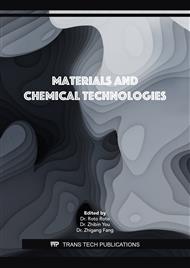[1]
Klemm, D., Heublein, B., Fink, H. P., et al. Cellulose: Fascinating Biopolymer and Sustainable Raw Material [J]. Angew. Chemie - Int. Ed. 2005, 44 (22), 3358–3393.
DOI: 10.1002/anie.200460587
Google Scholar
[2]
Fink H P, Weigel P, Purz H J, et al. Structure formation of regenerated cellulose materials from NMMO-solutions[J]. Progress in Polymer Science, 2001, 26(9):1473-1524.
DOI: 10.1016/s0079-6700(01)00025-9
Google Scholar
[3]
Penfield M P, Axelson M L. The behaviour of cellulose in hydrated melts of the composition LiXċn H2O (X=I−, NO3−, CH3COO−, ClO4−) [J]. Cellulose, 1999, 6(3):213-219.
Google Scholar
[4]
Thomas Heinze,René Dicke,Andreas Koschella,Arne Henning Kull,Erik‐Andreas Klohr,Wolfgang Koch. Effective preparation of cellulose derivatives in a new simple cellulose solvent[J]. Macromolecular Chemistry and Physics,2000,201(6):.
DOI: 10.1002/(sici)1521-3935(20000301)201:6<627::aid-macp627>3.0.co;2-y
Google Scholar
[5]
Cai J, Zhang L. Rapid Dissolution of Cellulose in LiOH/Urea and NaOH/Urea Aqueous Solutions[J]. Macromolecular Bioscience,2005,5(6):.
DOI: 10.1002/mabi.200400222
Google Scholar
[6]
Fischer S, Leipner H, K Thümmler, et al. Inorganic Molten Salts as Solvents for Cellulose[J]. Cellulose, 2003, 10(3):227-236.
DOI: 10.1023/a:1025128028462
Google Scholar
[7]
Jessop, P. G., Heldebrant, et al. Reversible Nonpolar to Polar Solvent [J]. Nature 2005, 436 (August), 1102.
DOI: 10.1038/4361102a
Google Scholar
[8]
Zhang, Q., Oztekin, N. S., et al. Activation of Microcrystalline Cellulose in a CO2-Based Switchable System [J]. ChemSusChem 2013, 6 (4), 593–596.
DOI: 10.1002/cssc.201200815
Google Scholar
[9]
Xie, H., Yu, X., Yang, Y., et al. Capturing CO2 for Cellulose Dissolution [J]. Green Chem. 2014, 16 (5), 2422–2427.
Google Scholar
[10]
Pei, M., Peng, X., et al. Synthesis of Water-Soluble, Fully Biobased Cellulose Levulinate Esters through the Reaction of Cellulose and Alpha-Angelica Lactone in a DBU/CO2/DMSO Solvent System [J]. Green Chem. 2020, 22 (3), 707–717.
DOI: 10.1039/c9gc03149a
Google Scholar
[11]
Onwukamike, K. N., Grelier, S., et al. Critical Review on Sustainable Homogeneous Cellulose Modification: Why Renewability Is Not Enough [J]. ACS Sustain. Chem. Eng. 2019, 7 (2), 1826–1840.
DOI: 10.1021/acssuschemeng.8b04990
Google Scholar
[12]
Onwukamike, K. N., Grelier, S., et al. Sustainable Transesterification of Cellulose with High Oleic Sunflower Oil in a DBU-CO2 Switchable Solvent [J]. ACS Sustain. Chem. Eng. 2018, 6 (7), 8826–8835.
DOI: 10.1021/acssuschemeng.8b01186
Google Scholar
[13]
Onwukamike, K. N., Tassaing, et al. Detailed Understanding of the DBU/CO2 Switchable Solvent System for Cellulose Solubilization and Derivatization. ACS Sustain [J]. Chem. Eng. 2018, 6 (1), 1496–1503.
DOI: 10.1021/acssuschemeng.7b04053
Google Scholar
[14]
Guo, Y., Li, L., Guo, G., et al. Synthesis of a Fully Biobased Cellulose-3-(2-Hydroxyphenyl) Propionate Ester with Antioxidant Activity and UV-Resistant Properties by the DBU/CO2/DMSO Solvent System [J]. Green Chem. 2021, 23 (6), 2352–2361.
DOI: 10.1039/d0gc03478a
Google Scholar
[15]
Jin, L., Gan, J., Hu, G., et al. Preparation of Cellulose Films from Sustainable CO2/DBU/DMSO System [J]. Polymers (Basel). 2019, 11 (6), 994.
DOI: 10.3390/polym11060994
Google Scholar
[16]
Pan, B., Huang, J., Chen, L. et al. Preparation of Corn Cellulose Films with Controllable Mechanical Property by UsingSwitchable CO2/DBU/DMSO System [J]. J. Polym. Mater. 2020, 37 (1), 17–27.
Google Scholar
[17]
Onwukamike, K. N., Lapuyade, L., et al. Sustainable Approach for Cellulose Aerogel Preparation from the DBU-CO2 Switchable Solvent [J]. ACS Sustain. Chem. Eng. 2019, 7 (3), 3329–3338.
DOI: 10.1021/acssuschemeng.8b05427
Google Scholar
[18]
Nanta, P., Skolpap, W., Kasemwong, K., et al. Dissolution and Modification of Cellulose Using High-Pressure Carbon Dioxide Switchable Solution [J]. J. Supercrit. Fluids 2017, 130 (March), 84–90.
DOI: 10.1016/j.supflu.2017.07.019
Google Scholar
[19]
Kirchberg, A., Meier, M. A. R. Regeneration of Cellulose from a Switchable Ionic Liquid: Toward More Sustainable Cellulose Fibers [J]. Macromol. Chem. Phys. 2021, 2000433.
DOI: 10.1002/macp.202000433
Google Scholar
[20]
Junchen, H., Fei, L., Haining, N., et al. A method and system for dissolving cellulose[P]. CN201910548376.9, 2019(in Chinese).
Google Scholar
[21]
Li, J., Lu, et al. Structure and Properties of Regenerated Cellulose Fibers Based on Dissolution of Cellulose in a CO2 Switchable Solvent. ACS Sustain [J]. Chem. Eng. 2021, 9 (13), 4744–4754.
DOI: 10.1021/acssuschemeng.0c08907
Google Scholar
[22]
Abitbol, T., Rivkin, A., Cao, Y., et al. Nanocellulose, a Tiny Fiber with Huge Applications [J]. Curr. Opin. Biotechnol. 2016, 39 (I), 76–88.
DOI: 10.1016/j.copbio.2016.01.002
Google Scholar
[23]
Klemm, D., Kramer, F., Moritz, S., et al. Nanocelluloses: A New Family of Nature-Based Materials [J]. Angew. Chemie - Int. Ed. 2011, 50 (24), 5438–5466.
DOI: 10.1002/anie.201001273
Google Scholar
[24]
Prakobna, K., Galland, S., Berglund, L. A. High-Performance and Moisture-Stable Cellulose-Starch Nanocomposites Based on Bioinspired Core-Shell Nanofibers [J]. Biomacromolecules 2015, 16 (3), 904–912.
DOI: 10.1021/bm5018194
Google Scholar
[25]
Liu, Y. Strong and Flexible Nanocomposites of Carboxylated Cellulose Nanofibril Dispersed by Industrial Lignin. ACS Sustain [J]. Chem. Eng. 2018, 6 (4), 5524–5532.
DOI: 10.1021/acssuschemeng.8b00402
Google Scholar
[26]
Qiu, C., Zhu, K., et al. Super Strong All-Cellulose Composite Filaments by Combination of Inducing Nanofiber Formation and Adding Nanofibrillated Cellulose [J]. Biomacromolecules 2018, 19 (11), 4386–4395.
DOI: 10.1021/acs.biomac.8b01262
Google Scholar


